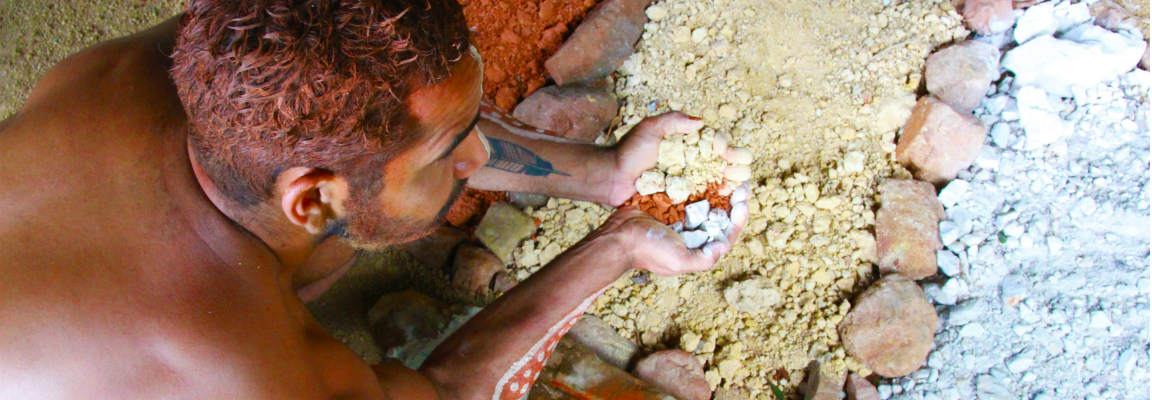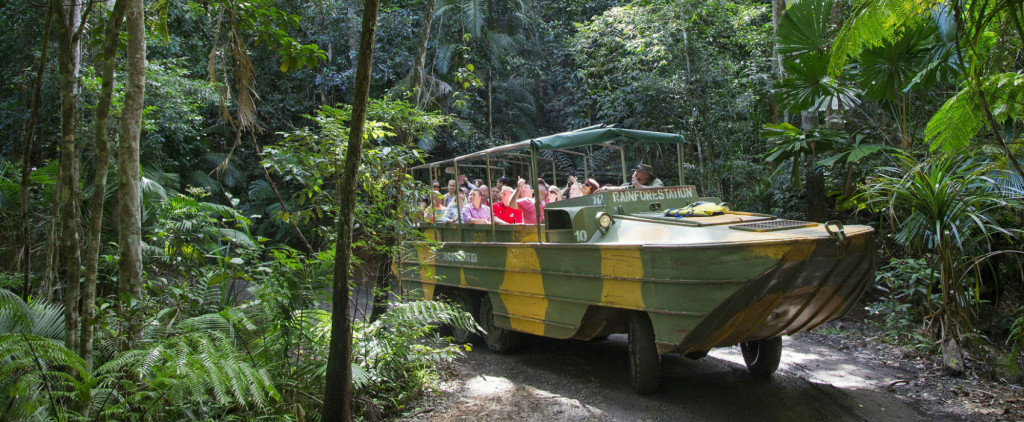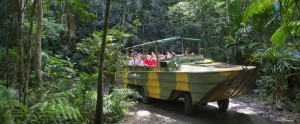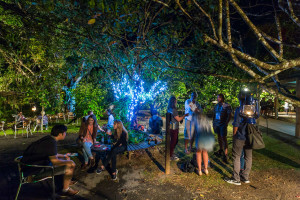Rainforestation is proud to own and operate 12 Army Duck amphibious vehicles. They’re a lot of fun to ride in, and a great way to explore the rainforest. But where did they come from? The Army Duck history is quite fascinating!
Army Duck History
One of the most originally conceived vehicles in military history, the Army DUKW (Duck) was produced as a solution to a problem encountered in the early days of the Pacific conflict – time and again American supply vessels found themselves standing off shore from beleaguered forces with no way of landing vital supplies. In response, two men, Palmer Cosslet Putham and Rod Stephens, envisaged an amphibious vehicle capable of ferrying men and cargo from ship to beach. The Army Duck was to become the product of their innovation.
Design
As a basis for their design Putham and Stephens chose the tried and tested General Motors two and a half ton truck. A waterproof hull was substituted for the truck’s standard bodywork and a propeller and rudder added for operation in water. Although these additions elevated the weight of the completed vehicle to over six tons, 85% of Duck parts were in common with the original GM truck, an important consideration in keeping to a minimum any teething problems that might occur with the new vehicle. Only thirty-eight days after the completion of the mock-up the first Duck rolled out of the workshop.
Trials & Tribulations
From the outset the project met with skepticism from many elements within the military establishment and even after initial demonstrations enthusiasm was muted. One last attempt to win the Brass over was organised, otherwise the Duck seemed destined to join a long list of military oddities that had seemed like a good idea at the time. Then luck took a hand. Four days prior to the demonstration a Coast Guard vessel ran aground nearby in heavy seas. When all other attempts to recover the stranded crew failed the Coast Guard requested help and the two Ducks being prepared for the demonstration were rushed to the scene.
In heavy seas the two ducks successfully retrieved the crew. Shortly afterwards the vessel broke up. Over the next few days the story of the dramatic rescue was widely publicized and the subsequent demonstrations were well attended. Gradually the military began to recognize the potential of the new vehicle. The Army Duck was finally on the way to becoming the huge success it was ultimately to prove.
Wartime Usage
The DUKW was supplied to the US Army, US Marine Corps and Allied forces. 2,000 were supplied to Britain under the Lend-Lease program and 535 were acquired by Australian forces, 586 were supplied to the Soviet Union, becoming the basis for the BAV 485.
The DUKW was used in landings in the Mediterranean, Pacific, on the D-Day beaches of Normandy, Operation Husky, and during Operation Plunder.
After the War
After World War II, reduced numbers of DUKWs were kept in service by the United States, Britain, France and Australia with many more stored pending disposal. Australia transferred many to Citizens Military Force units. The US Army reactivated and deployed several hundred DUKWs at the outbreak of the Korean War with the 1st Transportation Replacement Training Group providing crew training. DUKWs were used extensively to bring supplies ashore during the Battle of Pusan Perimeter and in the amphibious landings at Inchon.
Ex-US Army DUKWs were transferred to the French military after World War II and were used by the Troupes de marine and naval commandos. Many were used for general utility duties in overseas territories. France deployed DUKWs to French Indochina during the First Indochina War. Some French DUKWs were given new hulls in the 1970s with the last being retired in 1982. The Royal Marines still use a small number of these vehicles for training purposes in Scotland.
Army Ducks in Australia
Although DUKWs were used predominantly for the military, many were used by civilian organizations such as police departments, fire stations and rescue units. The Australian Army loaned two DUKWs and crew to Australian National Antarctic Research Expeditions in 1948 for an expedition to Macquarie Island. Australian DUKWs were used on Antarctic supply voyages until 1970.
From 1945 to 1965, the Commonwealth Lighthouse Service supply ship Cape York carried ex-Army DUKWs for supplying lighthouses on remote islands. Several were used by abalone fishermen of San Luis Obispo County California to take their catch right off the boats and directly to market, neatly combining the two steps of off-loading onto smaller craft, and then transferring to trucks once they reached the beach.
Whenever a natural disaster or an emergency situation occurs, DUKWs are well equipped for the land and water rescue efforts. Australian Army Reserve DUKWs were used extensively for rescue and transport during the 1955 Hunter Valley floods. One of the last DUKWs manufactured in 1945 was loaned to a fire department during the Great Flood of 1993 and in 2005, Duck Riders of Grapevine, TX deployed the vehicle to help in the aftermath of Hurricane Katrina. The DUKW was well equipped to maneuver its way through flood waters, transporting victims stranded on their rooftops to helicopter pads set up throughout New Orleans.
Army Duck Manufacturing
Our twelve Army Ducks were all built between 1942 and 1944 in Detroit, Michigan, USA, and can carry 30 passengers each.
The designation of DUKW is not a military pun – the name comes from the model naming terminology used by GMC;
- the D indicates a vehicle designed in 1942,
- the U meant “utility (amphibious)”,
- the K indicated all-wheel drive and
- the W indicated two powered rear axles.
The DUKW prototype was built around the cab over engine (COE) six-wheel-drive military truck GMC ACKWX , with the addition of a watertight hull and a propeller. The final production design was based on the CCKW. The vehicle was built by the GMC division of General Motors (called Yellow Truck and Coach at the beginning of the war). It was powered by a GMC Straight-6 engine of 270 in³ (4.416 litre).
The DUKW weighed 7.5 tons and operated at 6.4 mph (10 km/h) on water and 50-55 mph (80 km/h) on land. It was 31 feet (9.3 m) long, 8.25 feet (2.4 m) wide, and 8.8 feet (2.6 m) high with the folding-canvas top up. 21,137 were manufactured. It was not an armored vehicle, being plated with sheet steel between 1/16″ and 1/8″ thick to minimize weight.
A high capacity bilge pump system kept the DUKW afloat if the thin hull was breached by holes up to 2″ in diameter. The DUKW was the first vehicle to allow the driver to vary the tire pressure from inside the cab, an accomplishment of Speir’s device. The tires could be fully inflated for hard surfaces such as roads and less inflated for softer surfaces—especially beach sand.
Petrol consumption is 4-6 mpg (1 kpl) on land, and 1 mpg (0.3 kpl) in water. However, recently our fleet of Army Ducks was converted to run off LPG gas. This is a much cleaner and greener fuel than petrol and reduces our greenhouse emissions by over half.
Army Ducks Today
DUKWs are still in use today, as well as purpose-built amphibious tour buses, primarily as tourist transport in many attractions world wide. In Australia the largest fleet of DUKWs is right here at Rainforestation, North Queensland. The first DUKW was acquired by Rainforestation owners Charles and Pip Woodward in 1975 and there are currently twelve DUKWs operating on a daily basis. To ensure the DUKWs are maintained well here at Rainforestation we have two full time engineers do any running repairs. Most parts for the DUKWs can still be purchased through General Motors and for those bits that are no longer available to us, our engineers make the parts.




